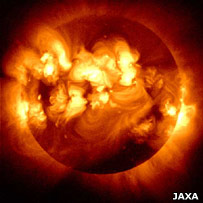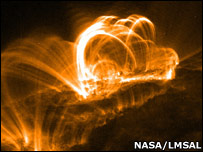|
By Jonathan Amos
Science reporter, BBC News
|

 |
Solar-B's orbit gives it a near-continuous view of the Sun

|
Scientists have high hopes for Japan's Solar-B mission which has been launched from the Uchinoura spaceport.
The spacecraft will investigate the colossal explosions in the Sun's atmosphere known as solar flares.
These dramatic events release energy equivalent to tens of millions of hydrogen bombs in just a few minutes.
The probe will attempt to find out more about the magnetic fields thought to power solar flares, and try to identify the trigger that sets them off.
The ultimate goal for scientists is to use the new insights to make better forecasts of the Sun's behaviour.
Flares can hurl radiation and super-fast particles in the direction of the Earth, disrupting radio signals, frying satellite electronics, and damaging the health of astronauts.
Solar-B lifted off from Uchinoura, at the southern tip of Japan, at 0636 local time on Saturday (2136 GMT Friday).
"It will take two to three weeks to transfer the spacecraft into its so-called Sun-synchronous polar orbit. From this position, Solar-B will be able to observe the Sun without having any nights for eight months of the year," said Professor Tetsuya Watanabe, of the National Astronomical Observatory of Japan (NAOJ).
As is customary on Japanese missions, the satellite will get a new name once it is ready to begin its work.
The spacecraft, developed by the Japanese space agency (Jaxa) and the Mitsubishi Electric Corporation, has scientific and engineering contributions from, principally, the US and the UK.
'Fine detail'
The Sun behaves like a giant twisting magnet; and when contorted field lines that have lifted up off the surface of the star clash, they release a colossal maelstrom of energy.
A blast of intense radiation is emitted, and charged particles are accelerated out into the Solar System. Some of these particles are moving so fast they can cover the 149 million km to Earth in just tens of minutes.

The flares can have a serious impact on Earth's environment
|
Whilst scientists understand the flaring process reasonably well, they cannot predict when one of these enormous explosions will occur.
Solar-B is expected to transform our understanding.
It carries three instruments: a Solar Optical Telescope (SOT), an X-ray Telescope and an Extreme Ultraviolet Imaging Spectrometer.
They will make continuous, simultaneous observations of specific solar features, to observe how changes in the magnetic field at the Sun's surface can spread through the layers of the solar atmosphere to produce, ultimately, a flare.
"Solar-B acts essentially like a microscope, probing the fine details of what the magnetic field is doing as it builds up to a flare," said mission scientist Professor Louise Harra, from the Mullard Space Science Laboratory, UCL, UK.
"What we don't know is what triggers a flare; we don't understand the physics of that phase at all. Solar-B will show us how tangled the field is, and how the field lines collide to produce all that energy."
Space dependence
Solar-B is but one of a fleet of spacecraft now dedicated to understanding the relationship between the Sun and the Earth; and more are set to follow.
Next month, the US space agency (Nasa) plans to launch its Stereo mission - twin spacecraft that will make 3D observations of our star.

Scientists would like to predict the onset of solar flares
|
As we become more reliant on space-based systems - to provide us with everything from timing and positioning services to the relay of telecoms data - the need to understand the tempestuous Sun-Earth interaction just gets more urgent.
Losing a satellite because of solar flare effects could prove costly, not just in economic terms but in human lives.
Spacecraft like Solar-B should give scientists the data they need to make better "space weather" forecasts.
"The information that Solar-B will provide is significant for understanding and forecasting of solar disturbances, which can interfere with satellite communications, electric power transmission grids, and threaten the safety of astronauts travelling beyond the safety of the Earth's magnetic field," said John Davis, Solar-B project scientist at Nasa's Marshall Center.
Jonathan.Amos-INTERNET@bbc.co.uk